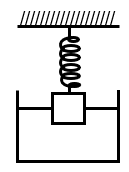A uniform cylinder of length L and mass M having cross-sectional area A is suspended, with its length vertical, from a fixed point by a massless spring, such that it is half submerged in a liquid of density at equilibrium position. The extension x0 of the spring when it is in equilibrium is :
(Here k is spring constant)

This problem involves a cylinder suspended by a spring and partially submerged in a liquid. At equilibrium, the forces acting on the cylinder are balanced. Let's analyze these forces step by step.
Step 1: Identify the forces acting on the cylinder at equilibrium.
Three forces act on the cylinder:
Step 2: Apply the condition for equilibrium.
For the cylinder to be in equilibrium, the net force on it must be zero. The two upward forces (spring and buoyancy) must balance the downward force (weight).
Therefore, we can write the force balance equation:
Substituting the expression for :
Step 3: Solve for the extension .
Rearrange the equation to isolate :
Factor out from the numerator:
This simplifies to the final expression for the spring extension at equilibrium:
Final Answer: Comparing this result with the given options, the correct one is:
Hooke's Law: The force exerted by a spring is proportional to its extension or compression from its natural length. , where is the spring constant and is the displacement.
Archimedes' Principle: When a body is partially or fully submerged in a fluid, it experiences an upward buoyant force equal to the weight of the fluid displaced by the body. , where is the volume of fluid displaced.
Equilibrium Condition: For any object in static equilibrium, the vector sum of all forces acting on it is zero. .